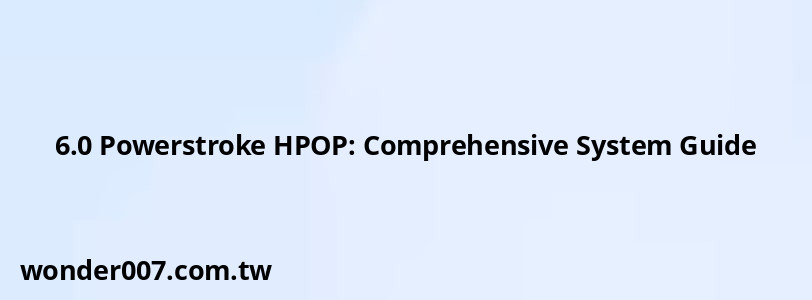6.0 Powerstroke HPOP: Comprehensive System Guide

The 6.0 Powerstroke High Pressure Oil Pump (HPOP) is a critical component of the engine's fuel injection system. This guide will provide a detailed overview of the HPOP system, its components, and their functions.
High Pressure Oil System Components
The high pressure oil system in a 6.0 Powerstroke engine consists of several key components:
- High Pressure Oil Pump (HPOP): A cam gear driven pump that pressurizes oil for the fuel injection system.
- Injection Pressure Regulator (IPR) Valve: Controls pressure in the HP oil system.
- High Pressure Oil Rails: Act as a manifold to supply oil to the injectors.
- Standpipes: Connect the branch tube to the high pressure oil rails.
- Branch Tube: Feeds high pressure oil to each bank of injectors.
- STC (Snap-To-Connect) Fitting: Connects the HPOP to the branch tube.
- Fuel Injectors: Use high pressure oil to intensify and inject fuel.
HPOP Function and Operation
The HPOP is the heart of the high pressure oil system. It operates as follows:
1. Oil is picked up from the oil pan by the low-pressure oil pump.
2. The oil is sent through the oil cooler and filter into the HP oil reservoir.
3. The HPOP pressurizes the oil, potentially up to 3,000 PSI.
4. Pressurized oil is sent to the oil rails and fuel injectors.
The IPR valve works in conjunction with the Injection Control Pressure (ICP) sensor to regulate system pressure. The PCM controls the IPR valve's duty cycle to adjust pressure as needed.
Common Failure Points
Several areas in the high pressure oil system are prone to failure:
- STC Fitting: Particularly in 2005-2007 models, the internal seal can wear prematurely.
- Standpipe and Dummy Plug O-rings: These can fail, causing oil leaks.
- HPOP: Early models (2003-2004) used an aluminum body pump prone to failure.
- Branch Tube: Can develop leaks at connection points.
Diagnostic Procedures
When diagnosing HPOP system issues:
1. Check for visible oil leaks around the HPOP, standpipes, and dummy plugs.
2. Use a scan tool to monitor ICP sensor readings and IPR duty cycle.
3. Perform a high pressure oil system integrity test using compressed air.
4. Inspect the oil reservoir and filter for contamination.
Replacement Considerations
When replacing the HPOP:
- Always use new O-rings and seals.
- Clean all mating surfaces thoroughly.
- Apply appropriate sealant where specified.
- Torque all bolts to manufacturer specifications.
- Bleed the system properly after installation.
Remember, working on the high pressure oil system requires expertise and caution due to the extremely high pressures involved.
Related Posts
-
Jeep Grand Cherokee 3.7: Serpentine Belt Diagram Guide
28-01-2025 • 134 views -
Cabin Air Filter: Essential Guide for 2018 Hyundai Elantra
30-01-2025 • 247 views -
Chrysler Town And Country Remote Start: A Comprehensive Guide
28-01-2025 • 153 views -
Cabin Air Filter 2005 Chevy Colorado: Essential Guide
27-01-2025 • 233 views -
Left Rear Turn Signal Lamp Out: Troubleshooting Guide
29-01-2025 • 205 views
Latest Posts
-
Are O2 Sensors Covered Under Warranty
01-02-2025 • 376 views -
Power Steering Fluid Leak On Passenger Side
01-02-2025 • 457 views -
How To Turn Off Paddle Shifters Mercedes
01-02-2025 • 377 views -
Rear Brake Caliper Piston Won't Compress
01-02-2025 • 356 views -
2015 Chevy Traverse AC Recharge Port Location
01-02-2025 • 409 views
Popular Posts
-
V12 Engine Costs: What You Need to Know
26-01-2025 • 679 views -
EPC Warning Light: What It Means for Your Vehicle
27-01-2025 • 630 views -
Hino Warning Lights: Understanding Dashboard Alerts
26-01-2025 • 765 views -
EPC Light: Understanding Causes and Solutions
26-01-2025 • 1053 views -
Power Steering and ABS Light On: Causes and Solutions
27-01-2025 • 643 views
